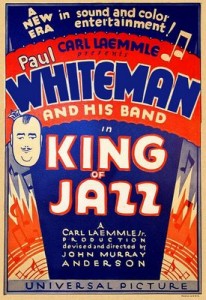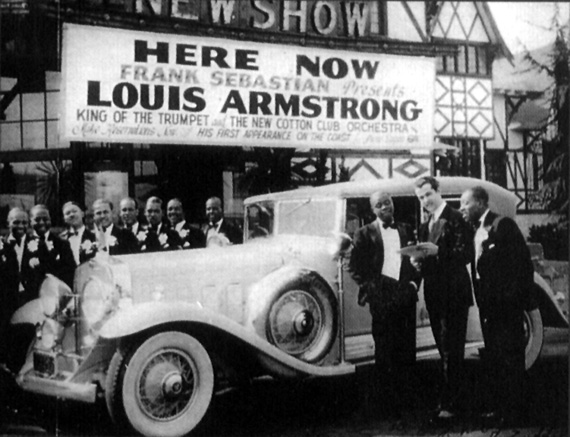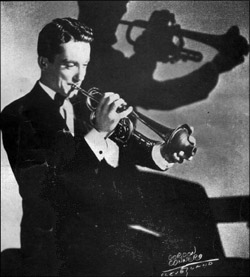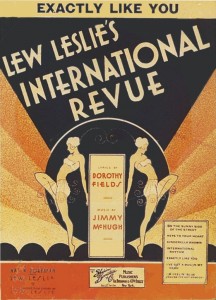The full impact of the stock market collapse and the effects of the coming Depression had yet to be realized in early 1930. President Herbert Hoover gave his famous speech in February, claiming that the "worst of the Depression would be over within 90 days." He would promise, "Prosperity is just around the corner."
The President couldn't have been more wrong. Bank failures multiplied alarmingly. By year's end Hoover had urged Congress to provide up to $150 million for public works to create jobs. There were 6,000 apple-sellers on the streets of New York City alone.
Jazz too, took a hard blow. Record sales were down and there were far fewer dance-band gigs around. Jazz orchestras broke up or down-sized. The Jazz Age was over; the Roaring 20s reduced to a sigh. 'Surviving on a song' became a way of life for millions of Americans. “Make do—or do without” was the motto of the day.
Hollywood movie studios still turned out product and seemed immune to the collapse, but there were changes. After more than a year's delay and a too-lavish budget, The King of Jazz starring Paul Whiteman, the biggest act in show business in the 20s, proved to be a spectacular flop at the box office in 1930. Whiteman's career never recovered, but Bing Crosby's role in the King of Jazz marked the beginning of his rise to super stardom.
Duke Ellington was well on the road to celebrity in 1930. Every night of the week live CBS remote broadcasts from Harlem’s Cotton Club delivered the Duke Ellington Orchestra to living rooms coast to coast. Ellington compositions to hit the airwaves in 1930 include "Ring Dem Bells" and "Mood Indigo."
Hollywood and its glitter drew both Ellington and Louis Armstrong to the West Coast in 1930. Ellington and his band appeared in the Amos 'n Andy film Check and Double Check. Armstrong fronted the house band at Sebastian's New Cotton Club, a Culver City nightclub, just blocks away from the MGM studios. Armstrong made scores of great recordings in 1930 with this band in L.A., featuring young Lionel Hampton on drums.
1930 marked a significant change in the sound of jazz-oriented bands in New York, on radio, in recordings and live performance. That year Red Nichols, who'd been the most trend-setting white recording session leader of the 1920s, hired young men from the South and Midwest who infused his band with new rhythmic vitality and sophistication. Texan Jack Teagarden, with his amazing facility on the trombone and warm, blues-y singing style, and the formidable Chicagoan Benny Goodman on clarinet, brought previously-unheard swinging virtuosity to jazz soloing. But it was the 4-beat bass drumming of Gene Krupa that would revolutionize rhythm playing. Along with new approaches to arranging, these rhythmic innovations would set the stage for the 'swing' style that would come to dominate jazz in the near future.
By 1930 the average New York theater-goer could barely afford a $3 orchestra ticket, and Broadway musicals faced declining ticket sales. Despite economic woes, Broadway saw new heights of creativity from frothy 'escapist' fantasy to serious and satirical social and political commentary. 1930 was a year that debuted some of the greatest theater songs to be adopted by jazz interpreters, forming a cornerstone of present-day jazz repertoire.
Jimmy McHugh and Dorothy Fields wrote "Exactly Like You" and "On the Sunny Side of the Street" for Lew Leslie's International Revue, and George and Ira Gershwin created three golden hits in one show, Girl Crazy—"Embraceable You," "But Not for Me," and a show-stopper introduced by newcomer Ethel Merman, "I Got Rhythm."
It’s hard to imagine the history of jazz without "I Got Rhythm." Except for the twelve-bar blues form, "I Got Rhythm" and its chord changes are the most common scaffolding for countless compositions, riff tunes, and off-the-cuff jam sessions. A jazz musician today instantly knows what to do when "Rhythm changes" are called on the bandstand.
Today we can only marvel that before 1930, "Rhythm," with its hopeful Depression-era lyric—Old man trouble/I don't mind him/You won't find him/Hangin' 'round—existed only in the minds of George and Ira Gershwin. Who could ask for anything more?
This week on Riverwalk Jazz The Jim Cullum Jazz Band celebrates the music that kept America swinging in the Great Depression with special guests—Nina Ferro and Vernel Bagneris on vocals and a special appearance by blues legend Jay McShann on piano.
Photo credit for Home Page: Songwriters Jimmy McHugh and Dorothy Fields, Los Angeles. Photo courtesy songbook1.wordpress.
Text based on Riverwalk Jazz script by Margaret Moos Pick © 2011






